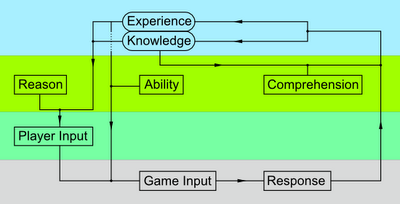
The diagram describes a game Situation, as defined in the provided link. The topmost region, colored in light blue, represents the player's accumulated Wisdom. The second region, in light green, defines the player's Attributes. The third region represents the player's mental workspace; what the player intends to communicate to the game*. The fourth region represents the game itself: the rules by which the game maps the Input the player actually provides to the particular Result that it offers.
A Situtation is a looping construct, in essence. It starts with the player becoming aware of a Situation, likely from a prior iteration of the loop. Then, the player uses Reason coupled with Knowledge and Experience to formulate a plan. This plan takes the form of a series of Inputs to the game that the player intends to send: the Player Input.
The player then attempts to deliver this Player Input to the game. The player invokes Ability, which is informed by Experience. This generates the Input that the game sees, the Game Input.
The game's Mapping Table is the set of all possible Game Inputs and their mapping to a game output. This Table need not be fully deterministic; randomness or chaos may enter into the outcome. So, via some means, the Game Input is mapped to the Result.
The player then processes the Result using Comprehension informed by Knowledge to generate new Knowledge and Experience. Not every situation will generate Knowledge or Experience, nor is there any guarentee as to whether the player actually understood all of the Knowledge or Experience that the game expected to deliver with a particular Result.
As a side note that will be important later on, the player's body of Knowledge includes some knowledge of what inputs the game can take at this time. However, this Knowledge may be incomplete or inaccurate.
Let the set Ig be the set of all valid Game Inputs. Let the set Ik be the set of inputs that the player has Knowledge of. There is no formal relationship between Ig and Ik, though it is usually a good idea if the there is some overlap between the two sets.
* The information in this region may be expanded upon later as the model is improved.
No comments:
Post a Comment